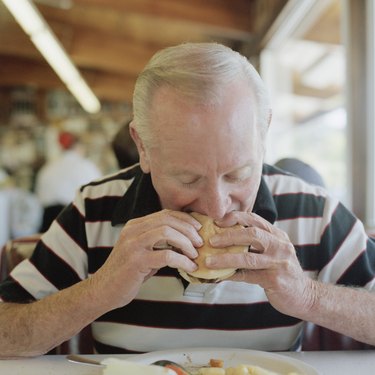
Calories -- formally known as kilocalories -- measure the amount of energy supplied by food and beverages. The number of calories your body requires to function and maintain itself depends on a variety of factors, including your body size, your metabolism, your activity level and your gender. While the 2010 Dietary Guidelines for Americans estimates that men in the United States consume an average of about 2,640 calories a day, normal caloric intake among individual men can range anywhere from 2,000 to 3,000 calories a day.
Average Caloric Intake for Men
Video of the Day
Given that men can consume as few as 2,000 calories or as many as 3,000 calories a day, the average man needs somewhere in the neighborhood of 2,500 calories a day to maintain his body weight and activity level. These calorie intake recommendations are based on estimated energy requirements for the average man, or what the USDA Center for Nutrition Policy and Promotion calls the "reference" man, who is 5 feet 10 inches tall and weighs 154 pounds. A taller or heavier man would, on average, require more calories, just as a shorter or slighter man would generally require fewer.
Video of the Day
Factors Affecting Calorie Needs
Calorie needs are only partially determined by body size. They're also substantially influenced by age, level of activity and overall body composition. Because calorie requirements for people of both genders tend to decline with age -- hormonal changes that come with age bring a decrease in lean muscle tissue and metabolism -- younger men normally need more calories than older men. For example, a moderately active 20-year-old man requires about 2,800 calories a day, whereas a moderately active 60-year-old man needs 400 fewer daily calories.
Regular physical activity increases calorie needs in obvious ways -- burning energy requires consuming more energy, unless you're trying to lose weight -- but exercise can also drive calorie needs by boosting metabolism and increasing lean muscle tissue. This helps explain why a 25-year-old sedentary man normally needs just 2,400 calories a day, while a 35-year-old active man requires closer to 3,000 calories.
Where Calories Come From
Caloric intake is simply a balancing act, and men whose weight doesn't fluctuate much over the course of time are doing a good job of meeting their bodies' energy needs. While zeroing in on calorie needs can be beneficial when it comes to weight management, making sure that those calories come from the right ratio of major nutrients is essential to overall health. The Institute of Medicine of the National Academies recommends that all adults should aim to get 45 to 65 percent of their calories from carbohydrates, 20 to 35 percent of their calories from fat and 10 to 35 percent of their calories from protein.
Not All Calories Are Equal
Not all calories are created equal, even if they all supply energy. In the United States, men get a significant number of their daily calories from grain-based desserts, sugar-sweetened beverages and alcohol -- all of which rank in the top 5 sources of calories for American adults, according to the 2010 Dietary Guidelines for Americans. Such foods and beverages may count toward your intake of carbohydrates, but they're largely in the form of added sugars, which are devoid of vitamins and minerals, and are generally bad for your health. Minimizing your consumption of processed foods and selecting nutrient-dense, whole foods as often as possible, can help you ensure that you're consuming quality calories, no matter what their quantity.
- NHS Choices: Understanding Calories
- NHS Choices: What Should My Daily Intake of Calories Be?
- USDA Center for Nutrition Policy and Promotion: Estimated Calorie Needs per Day by Age, Gender and Physical Activity Level
- USDA Food and Nutrition Service: Dietary Guidelines for Americans, 2010, Chapter 2 -- Balancing Calories to Manage Weight
- Institute of Medicine of the National Academies: Dietary Reference Intakes for Energy, Carbohydrate, Fiber, Fat, Fatty Acids, Cholesterol, Protein and Amino Acids